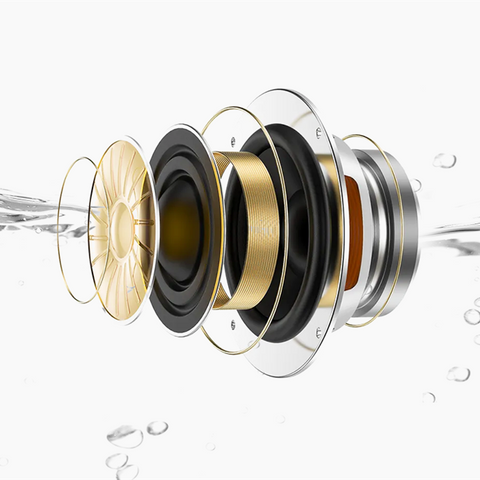Table of content
Bone conduction technology is a breakthrough technology that can help people with specific hearing problems. By transmitting sound vibrations directly to the inner ear through bone, it bypasses certain barriers, making it a promising alternative for people with hearing loss. However, are bone conduction headphones suitable for all deaf people?
This guide describes how bone conduction technology can benefit people with hearing loss. We examine the effectiveness of bone conduction headsets for deaf people, dissect how they work and whether they are a viable solution for different types of hearing impairment, and you can read on if you're interested.
Understanding Bone Conduction Technology

Before we dive into the suitability of bone conduction headphones for deaf people, it’s essential to grasp how bone conduction actually works. Unlike traditional headphones that transmit sound through the air into your ear canal, bone conduction headphones bypass the eardrum entirely. Instead, they use vibrations that travel through the bones of your skull directly to the cochlea (the hearing part of the inner ear). This allows users to hear sound without blocking the ears or needing to rely on the eardrum.
In theory, this could be revolutionary for those with certain types of hearing loss. The concept might sound complex, but once you break it down, it's quite simple: instead of relying on your ear canal to transmit sound, bone conduction headphones use vibrations to stimulate the hearing process directly through the bones of your head.
Related articles: How Bone Conduction Headphones Work?
Different Types of Deafness
1. Deafness or hearing loss can vary significantly in terms of its causes, severity, and the specific part of the auditory system that is affected. There are three primary types of deafness or hearing loss, each with distinct characteristics. Understanding these types helps in determining the appropriate treatment or intervention. Here are the different types of deafness:
2. Conductive Hearing Loss: Conductive hearing loss occurs when there is a problem in the outer or middle ear that prevents sound from being conducted properly to the inner ear (cochlea). It usually involves blockages or damage to the ear canal, eardrum, or the bones of the middle ear.
3. Sensorineural Hearing Loss (SNHL): Sensorineural hearing loss occurs when there is damage to the inner ear (cochlea) or the auditory nerve, which transmits sound signals to the brain. It is the most common type of permanent hearing loss and is usually irreversible.
4. Mixed Hearing Loss: Mixed hearing loss is a combination of both conductive and sensorineural hearing loss. This means there are issues in both the outer or middle ear and the inner ear or auditory nerve. It is often caused by a combination of factors, such as age-related hearing loss alongside an ear infection or trauma.
5. Central Hearing Loss: Central hearing loss is caused by damage to the brain or the central auditory pathways, rather than the ear itself. This type of hearing loss affects the way the brain processes sound signals that come from the ears.
6. Auditory Processing Disorder (APD): Auditory Processing Disorder is not a form of deafness in the traditional sense but refers to difficulty processing sounds correctly in the brain. Individuals with APD have normal hearing sensitivity, but their brain has trouble interpreting the sounds it receives.
Helpfulness and Limitations of Bone Conduction Technology in the Deaf Community

Helpfulness
Stimulus Reduction: One of the most significant advantages of bone conduction technology is its ability to bypass damaged outer and middle ear structures so that it can transmit sound vibrations directly to the skull, allowing the inner ear to perceive sound without the use of the outer or middle ear.
Situational Awareness: Unlike traditional headphones that cover or block the ear canal, bone conduction headphones keep the ear open, allowing the user to hear external sounds such as traffic, conversations, or emergency signals while enjoying music or audio. This feature is especially important for people who rely on their sense of hearing to understand their surroundings for safety reasons.
Comfort: Bone conduction headphones solve this problem by being placed on the cheekbones or temples, transmitting sound through the bone rather than blocking the ear canal. This non-invasive design provides all-day comfort without the pressure or discomfort of traditional earbud designs.
Versatility: Another great advantage of bone conduction headphones is their versatility, especially for those with active lifestyles. Whether you're a runner, cyclist, hiker, or just someone who enjoys outdoor adventures, bone conduction headphones allow you to stay connected to your audio while maintaining your ability to hear your surroundings.
Limitations
Limited sound quality: Bone conduction headphones are often inferior to conventional headphones in terms of sound quality, especially in bass and treble performance. For the deaf community that relies on sound quality, bone conduction headphones may not provide an ideal listening experience.
Limited adaptability: Bone conduction headphones are mainly suitable for people with moderate or mild hearing loss, and may have very limited effect on people with severe hearing loss or complete deafness.
No Replacement for Hearing Aids: Although a bone conduction headset transmits sound, it is not a device specifically designed to help deaf people regain their hearing. It cannot amplify or restore sound as effectively as a hearing aid or cochlear implant.
Conclusion
Bone conduction headphones offer a promising hearing solution for some people with hearing loss, especially conductive hearing loss. By transmitting sound vibrations directly to the inner ear, they can bypass problem areas in the outer and middle ear. While their effectiveness varies depending on the type of hearing impairment, these headphones can be a powerful tool for enhancing sound perception in some cases of deafness.








